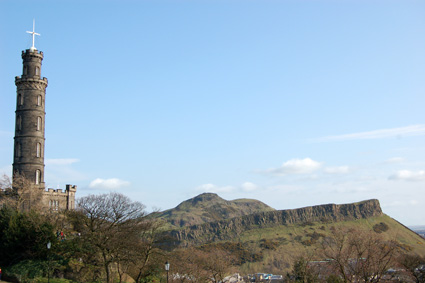
Arthur's Seat from Calton Hill
If there was one thing we hadn't expected to find it Scotland, it was sunny days. The sort of sun that counteracts the brisk chill of the wind. But, save for our last morning, we had skies only lightly scattered with clouds, leading us to spend our spare moments, of which we had many, slowly wandering the streets and parks of Edinburgh.
We hadn't planned but the littlest bit of our trip to Edinburgh until we had boarded the plane to leave Greece. We weren't even sure that we would spend all of our time there, and skimmed the guidebook for ideas. The city has no shortage of museums - many with similar enough names that we continually had to check the guidebook to ensure we were headed to the intended place - and is full of pleasant parks, ranging in size from miniature grassy plots to the massive Holyrood Park, with its lochs, crags and towering hills. But, as we looked through the recommendations for shopping - still needed a few souvenirs - we spotted a note about the Edinburgh Farmers' Market. It just happened to take place on Saturday morning, and made for an ideal introduction to the city.
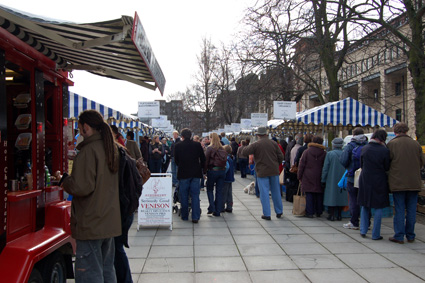
Edinburgh Farmers' Market
I'm a sucker for farmers' markets, if for no other reason than it helps me develop a feel for a place, in terms that I can understand. London's Borough Market shows a city that wants gourmet food, that wants an organic label, that wants the convenience of everything in one place. Its market exists in a specific place, a place that has no other purpose; it feels like a store. Those parts that are not currently useful, that will be selling something later, when its time comes, sit dark and empty.
In Edinburgh, the market sets up stalls along Castle Lane, in the shadow of Edinburgh Castle; it's temporary, small, and full almost to overflowing. Not just in terms of the shoppers, brushing past on the sidewalk, but in all of the stalls, as well. It's only as large as it has to be. There are no gaps. It's a local market, selling only what is available in season, which means plenty of meat at the end of March. Not just beef and pork - grass-fed, dry-aged beef; heritage pork breeds - but also wild game, which is impossible to find in the states.1 Wild venison, hare, wood pigeon, and plenty of others; it's probably best to keep alert for bird/buckshot lodged in the flesh, just in case.2 We also picked up some handmade chocolate truffles from Cocoa, full of interesting flavors like blackcurrant and pastis.
That week, all of the truffles had been made with Cuban chocolate. We'll never find that around here.
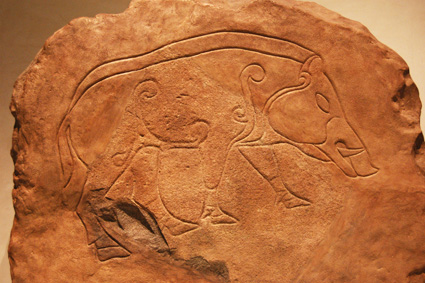
Prehistoric boar carving, Museum of Scotland
I also picked up a copy of The Scottish Farmers' Market Cookbook, by Nick Paul, who runs the Crisp Hut, making really nice potato chips with a variety of gourmet flavors. It's a recipe book, intended to get people to shop at their local markets, and has a couple of features that intrigue me:
- A directory of producers. Organized into categories of products, it lists producers attending a majority of the farmers' markets throughout Scotland, and includes contact information for all of them.
- Market dates and locations, including websites for information that may have changed since publication. It seems that most of the markets in Scotland operate on Saturdays, often only once per month.
- A list of peak seasonal availability of fruits and vegetables.3 If you're attempting to eat seasonally and locally, but prefer to cook from recipes, I'd imagine it's quite helpful to have this sort of reference.
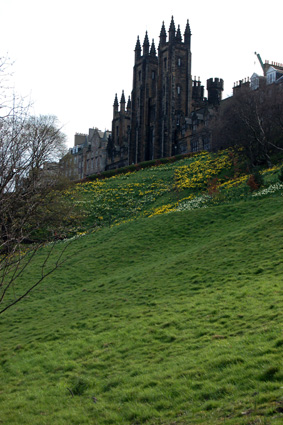
Princes Street Gardens and Old Town
Edinburgh, being in the UK, can be a real crapshoot when it comes to food. If you're willing to pony up some serious cash for one of the "Modern Scottish" restaurants - in general, places that are part of the emerging trend to focus on local, seasonal, and organic food, treated to bring out the natural flavors - you're probably safe, but cheap food tends to veer in the direction of deep-fried. Or little places, overbright with cold fluorescent lights, serving kebabs, burgers and pizza.5 And possibly something else entirely unrelated, like fish and chips.
So, where did we eat? A quite wonderful Thai restaurant, Songkran II, which was about twice as expensive as the places here in Madison, but the quality and presentation of the food were fantastic. My green curry - though noted as spicy on the menu, that was only in some bizarre British sense6 - was fullf of flavor, and well balanced; Sharon's orange chicken was not only lightly sauced - and not at all cloying, but just slightly sweet - but had a fantastically crisp skin. We also learned there that the Scots don't seem to go out to eat until 7:30pm or later, so we could get seats most anywhere as long as we were willing to eat early and not dawdle at the table.
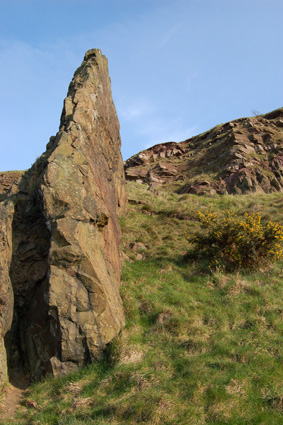
View from Radical Road
Another night was spent at David Bann, a trendy vegetarian place. The food was good, if sometimes a little unbalanced - wild mushroom and basil polenta; galette7 with adzuki beans and eggplant; watercress soup with purple sprouting broccoli and a poached egg; smoked tofu with stir-fried vegetables and sesame sauce; a dessert sampler for two, which included a pomegranate ice cream with redcurrant sauce - and well-presented, though the lighting was so dim that it was hard to tell. It also suffers from your typical European service, which is generally distant and brief. The same was true for La P'tite Folie, a little Breton cafe where we had lunch one day. The food was excellent - mussels in white wine and blue cheese; apple and brie in puff pastry; seared fish fillet with roast vegetables and mased potatoes; a lovely tartiflette - and we had a very pleasant bottle of Breton cider along with. But the staff was painfully French, living up to every snooty French stereotype we could imagine, except maybe chain-smoking.8 Ignore them, and it's a lunch spot well worth visiting.
Sharon also insisted that I have haggis while we were there, which is apparently a bigger deal for everyone who isn't me. Even a nice couple - British man, American woman - who sat with us at breakfast one morning, asked if we'd tried and if we knew what was in it. I didn't want to point out that I regularly keep assorted unusual (edible) animal parts in my freezer - they were eating breakfast, after all - but the notion of eating heart, liver and lungs doesn't much faze me. I even got Sharon to try a bite. She thought it was like Salisbury steak; it made me think of meatloaf with a slight offal flavor. Not the least bit offensive.

Gargoyle, Museum of Scotland
We ended up doing a little bit more of a tourist-type trip through Edinburgh, in part because we'd arrived in time for the weekend, and the warm, sunny weather seemed to bring everyone outside. Tops on the tourist circuit in Edinburgh? The Edinburgh Castle, though most everyone then funnels down the esplanade to poke into shops selling the usual pointless souvenirs based on broad ethnic and/or national stereotypes.
But, hey, we hadn't been suffering the ABCs,9 and we'd decided not to bother seeing the faux crown jewels in England. Edinburgh Castle has the real Scottish Honours on display, and though pictures are forbidden - though the guard was really quite nice to the two middle-aged women who didn't bother to notice any of the large signs - we figured it was worth it. I do have to say, though, that the tickets were really dull, and a disappointment after Greece. The Greeks may not have their act together in a variety of ways, but the tickets to their cultural attractions - from the Acropolis to the tiny little archaeological museum on Naxos - are genuinely lovely.

Edinburgh Castle atop rocky crags
So, it's a big castle, with the rigid geometry of manmade structures perched immediately atop the imposing, black rock. Sure, it's only black from the toxic air pollution of the Industrial Revolution and long years of coal stove exhaust, but it makes everything look even neater. The Honours are pretty enough, though I'll admit that the concept of royalty boggles my mind; and watching the crowds gather to watch the One O'Clock gun go off is pretty funny. It's a World War II-era artillery cannon that's fired at 1:00pm every day except Sunday, Christmas Day, and probably a handful of others. It goes boom; the crowds murmur about how loud it was; then they go back to taking pictures of themselves standing against the hilariously oversized cannon that is Mons Meg.
Also worthwhile, for a momentary detour, is St. Maragaret's Chapel. It's quite tiny, but the stained glass, up close, reminded me greatly of Stan Brakhage's hand-painted films. Not that it isn't impressive in a more traditional sense, but I was thrilled to find something - anything - in the real world that brought those films to mind.
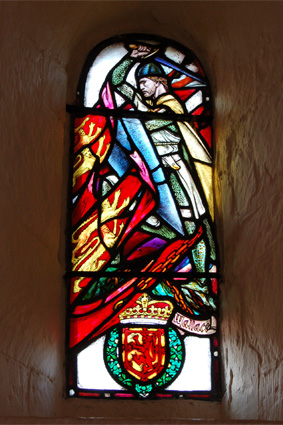
Stained glass, St. Margaret's Chapel
But it is very, very full of tourists. Many are quite kind about stepping out of the frame of your photographs - assuming you're kind enough to return the favor, of course - but it can be tough to make it look impressive in a photograph with a grumpy six-year old moping about. (He didn't like the hills and stairs, I gather.)
Fortunately, a visit to Calton Hill also requires enough climbing - not much, and none of it difficult - to keep half the hordes away. Located at the eastern end of New Town and Old Town, it offers some of the best easy-to-reach views of Edinburgh, as well as a cluster of monuments within spitting distance of each other: Robert Burns; Dugald Scott; Lord Horatio Nelson; and the Scottish National Monument, which is an intentional folly, not a project abandoned due to lack of funds, as the popular lore says.

Flowers on Calton Hill
Should you want some even more impressive views, then it's worth heading over to Holyrood Park. A former hunting ground for the Scottish king, it's a massive park surrounded by the city. Arthur's Seat, at the center, isn't quite a mountain, but it is the highest point in Edinburgh, and enough of a climb to thin out the crowds considerably. The peak isn't large, though, and folks tend to linger, but you can enjoy the rest of the park in relative solitude.
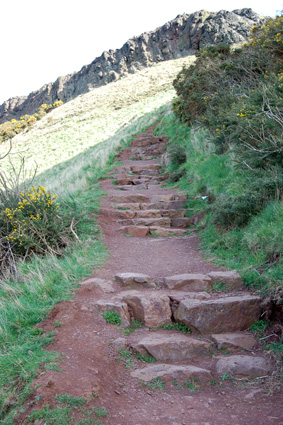
Stair to Arthur's Seat
But as impressive as the view is, it somehow feels separated from the city, even though it surrounds you on all sides. The park is so large that, no matter in which direction you look, it's almost as if you're looking upon Edinburgh from afar.
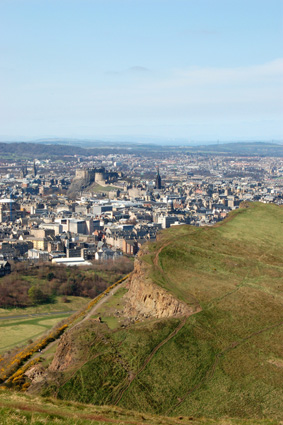
Edinburgh from Arthur's Seat
Should climbs not be your thing, the park still offers a wealth of meandering paths through Holyrood Park that can easily eat up an afternoon or more. It's an especially popular place for people with dogs - off the leash, there's no end to the possibilities for rooting about and smelling things - and looking up at Arthur's Seat and the Salisbury Crags from the valley between is nearly as lovely a picture as being up high. Though most of the wild animals that once made it a favored hunting ground are long gone - save for the swans, geese, and various species of ducks paddling about the lochs - it's perhaps the most pleasant city park I've seen in a long time. Maybe ever.

Salisbury Crags above Radical Road
The views from Salisbury Crags are definitely the best in the park, and from the top - a steep, trailless climb from the north end of Radical Road - you can experience them with almost no one else to bother you. When the ground drops away in nearly vertical, ragged rock faces, you can almost imagine that you're standing immediately atop the city. It's also one of the best places to get a good look at the new Scottish Parliament.
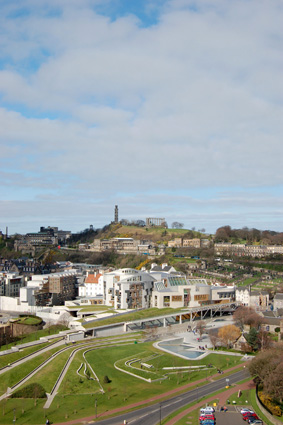
Scottish Parliament Building and Calton Hill
It's controversial, due to the collision of a variety of factors: it's architecturally daring; it ran well over budget; construction took far longer than originally estimated; the design architect, Enric Miralles, died suddenly shortly after construction started; and the man responsible for selecting Miralles' design, who was essentially the owner's representative, also died before the project was completed. It's the sort of building that tends to inspire strong feelings, especially in a city that's not overwhelmed with modern architecture.

Scottish Parliament Building
I think it's interesting, even if some of it's a little clunky. We didn't have a chance to see any of the interior, and I'm not sure how well it actually functions, but at least it's got a genuinely unique character. Even if Miralles did seem to be a fan of heavy-handed - if obtuse - symbolism. You know he was definitely using certain elements to make specific statements, but sometimes it's hard to tell what, exactly, he was trying to say. The fact that he didn't live to explain any of it doesn't help.
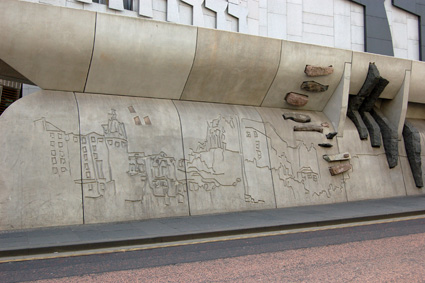
Scottish Parliament Building
Some of it works, though. The north wall features stones from all over Scotland, quotes from famous Scottish writers, and a large engraving made from a sketch Miralles made of Edinburgh during one of his visits. It's impossible to miss, at the end of the Royal Mile, and it's an irregular enough execution of a not-so-unusual concept to grab attention without being confusing.
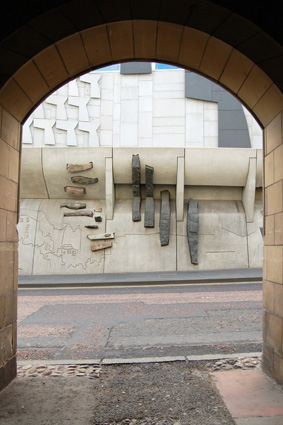
Scottish Parliament Building
The other modernist culture center in Edinburgh is the Museum of Scotland, which traces the history of the people who've lived in Scotland - and some of the non-people residents - from prehistory through the 20th century. I think. We didn't make it all of the way through; even devoting a full day is nowhere near enough time to give even a cursory pass through it all. We only got as far as the beginnings of the Industrial Revolution.
Part of the reason was that I was distracted by the installation works of Scottish artist Andy Goldsworthy on display amidst the prehistoric exhibits.
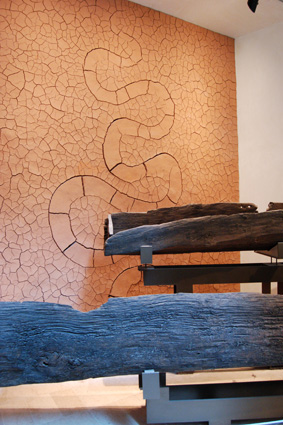
Clay wall sculpture, Andy Goldsworthy, Museum of Scotland
Andy Goldsworthy's works fall into two general categories: ephemeral art and installation art. All of his work is about expressing the qualities - often in non-intuitive ways - of natural materials, and of the effect that time and natural forces have on those materials. A sense of place, like terroir, is crucial; as a rule, just about everything he creates is going to fall apart. That's part of its life cycle. There are no unnatural elements - hidden structural supports or mortar keeping the stones in a wall fixed together. For his ephemeral works, which are usually made without the use of tools, the span of its existence is brief, and can even be as short as seconds. The installation pieces are more permanent, and though they may have been made with modern tools and skilled labor, they, too, will eventually be broken down by natural forces.
He has several clay walls at the museum, with images formed in the cracks as the clay dries. The clay came from nearby Dumfriesshire; the hair binding it, though it wasn't noted, is likely from a Scottish barber shop. The images formed on the surface are caused by forming structure behind the clay, which affects its rate of drying and creates the images.
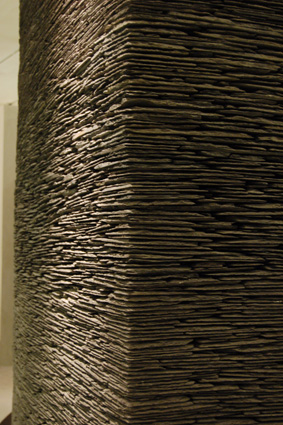
Slate wall sculpture, Andy Goldsworthy, Museum of Scotland
A circle of slate walls surrounds a group of exhibits, at least eight feet tall, composed of small, stacked sheets of stone. In the centers of these four walls - it's divided into quadrants to let people in and out - are circles, at least two feet in diameter, where the slate has been aligned in other directions, like vertical or diagonal. The sheer labor that went into it, layering all of those pieces without any mortar to bind, is impressive.
Nearby is a small cairn, composed of bleached whale bones collected from Scottish beaches. It's a miniature version of Goldsworthy's typical cairns - often of an area's local stone, though he's built them of other materials, including sheets of river ice - and like an abstraction of the coastal middens of the prehistoric peoples, the refuse heaps of mussel shells and such that prove humans have been enjoying seafood buffets on the beach for thousands of years.
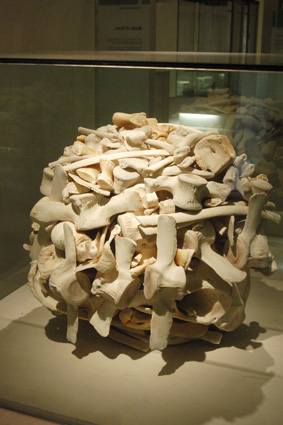
Whale bone cairn sculpture, Andy Goldsworthy, Museum of Scotland
And, once you've had enough of the walking and climbing and museum-going, you can do as we did, relaxing on the benches in the Princes Street Gardens, reveling in the carpet of daffodils signalling the arrival of spring.

Princes Street Gardens
* * * * *
1The USDA does not permit the sale of legally hunted wild animals, at least not those hunted in the US. If you see anything labeled as "wild" in a restaurant, then it's most likely the breed name, but raised domestically and slaughtered in an inspected slaughterhouse. Wild boar, for example, is just the name of the breed. Sometimes, restaurants will serve actual wild game; much of that comes from Scotland, where the sale of hunted animals is legal, and they're legal for sale here, too.
2Seriously.
3I now regret that I tossed it, but I had clipped a chart of seasonal availability for popular fruits and vegetables from the Chicago Tribune a few years ago. It was a horizontal sort of bar graph, brightly colored, quick to read and intuitive. One of these days, when I've settled down and grown comfortable with the markets around my home, I plan to create one for myself. Hey, Thomas Jefferson spent years noting the arrivals of new produce in the markets; if you want to eat with the seasons, it can't hurt to do a little legwork.
4Though a good number of the recipes in Jane Grigson's English Food - which I'd borrowed from Melissa while traveling, and read cover to cover - certainly are. Copious amounts of cream; a tendency to overcook, or occasionally undercook perfectly good vegetables; puddings, cakes, and other desserts with alarming quantities of sugar; and, in perhaps the most egregious culinary crime in the book, "Isle of Man Salt Duck", an entire duck is carefully given a light salt cure, then boiled. Boiled. Ignoring that most glorious possibility of duck: the crispy, crunchy skin. In Grigson's defense, though, I think it's an excellent survey of authentic British food, as far as culinary authenticity can go, and I plan on purchasing a copy for myself. It's not a collection of her recipes, but rather classic English ones, and she's good about pointing out that the British have the unfortunate habit of choosing bad food over good. Their reputation of having the world's worst food, while perhaps unfair, isn't coming entirely out of left field. And she finds evidence that the observation of awful British teeth goes back centuries, apparently.
5Maybe things have changed since my time in Brighton and Leeds, but as far as I'm concerned, British pizza is an abomination, a crime against both man and nature. German pizza, too. Likewise, Sharon doesn't have much that's positive to say about Japanese pizza.
6We joke about "Midwest Hot" as pretty mild compared to "East/West Coast Hot" here in Madison, at least with the other folks from places near oceans. (Though, occasionally, you'll find a place that'll do something akin to authentic Thai/Lao/Vietnamese levels of spiciness.) But "British Hot" makes "Midwest Hot" look downright sinus-clearing, as near as I can tell.
7Except that it was in crepes, not a galette. Sharon really liked it, but I felt that the mint in it was about as subtle as a hammer to the head.
8Edinburgh, like Madison, is a non-smoking town, and it's such a relief not to feel like you need a shower after you've been out for dinner or a drink.
9Another Bloody Church, Another Bloody Castle.

1 comment:
That Is Awesome :)
Post a Comment